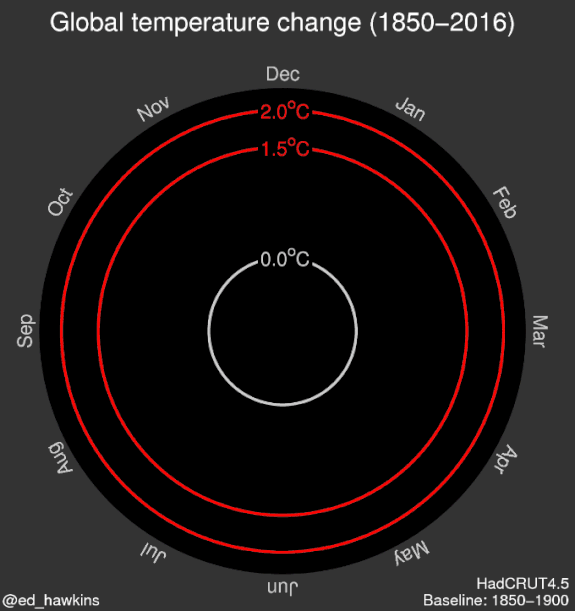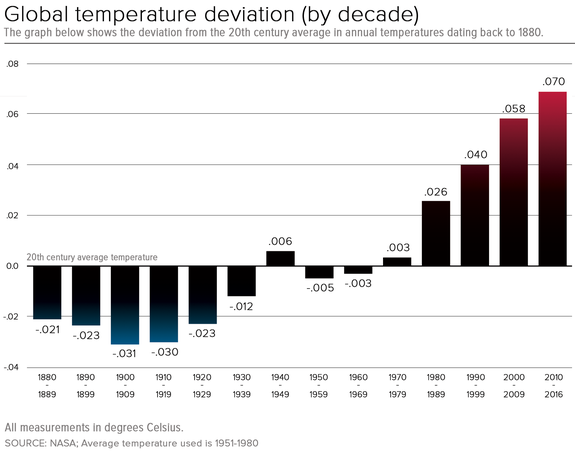2016 was Earth's warmest year on record, continuing a three-year streak

Last year was Earth's warmest on record since at least 1880, two federal agencies announced Wednesday.
Last year's global average surface temperature eclipsed previous highs set in 2014 and 2015. In fact, both NASA and the National Oceanic and Atmospheric Administration (NOAA) found that 2016's temperatures exceeded all previous years since instrument records began 137 years ago, and that human-caused global warming was responsible for a majority of the planetary fever.
Scientists are now warning that we should expect more such milestones in the years ahead, along with worsening climate impacts, as global warming progresses.
SEE ALSO: Obama directs $500 million to Green Climate Fund just before Trump takes office
Since the start of the 21st century, annual global temperature records have been broken five times — in 2005, 2010, 2014, 2015 and now last year.
"The string of records reflect the fact that we are going down a path that is dangerous and well-described," Sarah Myhre, an ocean and climate scientist at the University of Washington, told Mashable in an interview.
"It’s not a path that I would choose the international community to walk down and it’s not the path that I would choose for my son’s life in the future."

Image: bob al-greene/Mashable
“It’s precisely the fact that we see series of records being broken” that shows the dominant role that human-caused global warming is playing in altering the climate, said Gavin Schmidt, director of NASA's Goddard Institute for Space Studies in New York.
According to NOAA, global land and ocean surface temperatures were 0.94 degrees Celsius, or 1.69 degrees Fahrenheit, above the 20th century average, which beat the 2015 record by 0.04 degrees Celsius, or 0.07 degrees Fahrenheit. The first eight months of the year were each record warm, NOAA found.
Using independent methods, NASA found that globally-averaged surface temperatures in 2016 were 0.99 degrees Celsius, or 1.78 degrees Fahrenheit, warmer than the mid-20th century average. (NASA and NOAA differ in their base period as well as their precise methodology, which accounts for the divergent temperature findings.)
Taken separately, NOAA found that global land temperatures were the warmest on record last year, while ocean surface temperatures also set a record for the highest temperatures ever observed. ]

Image: Ed hawkins
VNot a single land area on the planet was cooler than average last year, NOAA found.
Instead, record high temperatures were noted across Far East Russia, Alaska, Far Western Canada, parts of the eastern U.S., much of Central America and northern South America, parts of Australia, as well as portions of Siberia and south Asia.
Global warming context
While the annual record is noteworthy, it's the long-term temperature trend that has climate scientists and world leaders worried.
According to NASA, the planet’s average surface temperature has risen about 1.1 degrees Celsius, or 2.0 degrees Fahrenheit, since the late 19th century, a change scientists blame on increased carbon dioxide and other human-released emissions into the atmosphere.
Global warming has broken more records in recent decades, with 16 of the 17 warmest years in NASA's records occurring since 2001.
The presence of a strong El Niño event in the tropical Pacific Ocean at the beginning of 2016 also boosted temperatures, according to scientists, though it was not sufficient by itself to set an annual temperature record.

Image: bob al-greene/mashable
By releasing more heat from the ocean into the atmosphere and altering weather patterns, El Niño events tend to boost global average temperatures.
Myhre, of the University of Washington, said records like this one are expected due to the buildup in greenhouse gases, such as carbon dioxide, in the atmosphere due to human activities.
She said the continuing progression of global warming is worrisome, even though it is well-understood from a scientific standpoint.
“As a scientist I would look at these continued record-breaking years and think 'yup, this makes sense, this is what I would assume would be happening based on my understanding,'" Myhre said.
“As a person, as a citizen, as someone who is raising a kid, these milestones are heartbreaking and terrifying, and I would say that what is it going to take? How many more milestones is it going to take?” she said in an interview.
“We all have to be a bit more emotionally honest about these kinds of milestones.”
Arctic differences
While the two agencies both concluded that 2016 ranks first on the list of warmest years, there are important differences between NOAA and NASA's methods that account for the disparity between the magnitude of temperature anomalies that scientists calculated.

Image: noaa
The NOAA data does not include much Arctic climate data since instruments are sparse in that vast region.
NASA, though, uses data interpolation techniques to account for Arctic temperatures. Since this was the warmest year on record in the Arctic, it's little surprise that NASA's average global temperature anomaly for 2016 is far higher than NOAA's.
The Arctic climate in 2016 was “almost off the scale" in its unusually high temperatures, according to NASA's Schmidt. In keeping with this observation, Arctic sea ice hit all-time lows in 2016, and has entered 2017 in a weakened state that could result in a record summer melt season.
Jessica Blunden, a scientist with ERT Inc. who helps maintain NOAA's climate database, said the agency's records may not have captured all of the "incredible warmth" seen in the Arctic this year.
Separately, the World Meteorological Organization, a U.N. agency, combined information from NOAA, NASA and two UK-based research institutions to also establish 2016 as the warmest year on record, with a temperature anomaly of about 1.1 degrees Celsius above the preindustrial era.
That anomaly is perilously close to the temperature target contained in the Paris Climate Agreement.
In that pact, which went into effect in Nov. 2016, world leaders committed to keeping global warming to well under 2 degrees Celsius, or 3.6 degrees Fahrenheit, above preindustrial levels, and also aimed for a more ambitious, though aspirational, 1.5-degree celsius, or 2.7 degrees Fahrenheit, target.
With 2016 already bumping up against the 1.5-degree mark, it’s clear that this target may be difficult, if not impossible, to adhere to.
"The window of time available for us to choose our future narrows with every year that goes by," said Katharine Hayhoe, a climate scientist at Texas Tech University, in an email.
"This record bears witness to the unprecedented experiment we are conducting with our planet: an experiment that puts us all at risk, the further we continue down this path."
Hayhoe and others emphasized that the annual record is just a data point, with many other long-term trends pointing to the seriousness of global warming.
“My main caution would be not to lose the forest for the trees. In the terms of understanding and tracking our changing world, this is only a very warm datapoint on a longer series that clearly defines our changing planet. It's the series that matters most, this year only reconfirms and adds to that understanding,” said Deke Arndt, chief of climate monitoring at NOAA’s National Centers for Climate Information.
2017 may not set another record
A press release from NASA accompanying Wednesday's announcement said researchers have found that the waning El Niño in 2016 increased the annual global temperature anomaly for 2016 by 0.12 degrees Celsius, or just 0.2 degrees Fahrenheit.
Perhaps to head off claims that most of the warming in 2016 was due to El Niño, Blunden said that compared to 1998, the last year with an extremely strong El Niño event, 2016 was more than a half-a-degree Fahrenheit warmer, owing largely to the additional influence of long-term warming. In the absence of global warming, one would expect 1998 and 2016 to be nearly equal in their temperature deviation from average, Blunden said.
The fact that El Niño has waned heading into 2017 means that it's less likely this year will set an annual temperature record, despite the continued presence of human-caused global warming.
"Short-term climate change includes the up-and-down of El Niño/La Niña, the up-and-down of the sun getting slightly brighter or dimmer and of explosive volcanos not blocking the sun with particles or else blocking it, and the up-and-up of the warming from rising carbon dioxide [concentrations]," said Richard Alley, a climate researcher at Penn State University, in an email.
"There is high likelihood that we will have years without new records in the near future; that does NOT mean that global warming stopped," Alley said.
Blunden told Mashable that even if the globe falls short of setting another temperature record in 2017, some parts of the world still will, such as the Arctic. And more global records will be around the corner, too.
“That just means that the impacts are starting to happen faster and faster. We are seeing the impacts of climate change now whether we’re hitting the records or not,” she said.
The 2016 record temperature news comes less than two days before President-elect Donald Trump enters the White House, having vowed to gut programs aimed at reducing emissions of greenhouse gases that are causing global warming.
